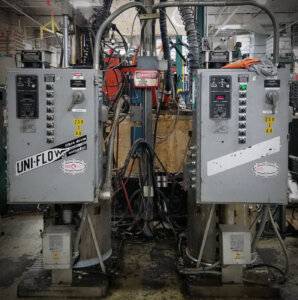Understanding the Roll Slitting Machine and Its Process

What is roll slitting?
Roll slitting isn’t a process that we’re all immediately familiar with—even if you’ve familiarized yourself with manufacturing processes, you may not be aware of this one. Roll slitting relates directly to paper, film, and foil, slitting them so that we can cut larger rolls of material and reshape them into narrower rolls. At its most basic form, roll slitting downsizes these products. This makes them easier to handle and more ideal for specific processes and products.
Keep in mind, though—there is also a process called “slitting steel”. This works with wide steel coils, feeding them into a slitter machine so that we can cut them into narrower strips. Even when it involves steel, slitting fundamentally is about narrowing a product.
What does a roll slitting machine do?
So, to get straight to it—what is the basic function of a roll slitting machine? How does this equipment work?
There are three main components that make up a typical roll slitting machine. These include the unwind, the slitter, and the rewind. The unwind relates directly to the slitter in that we feed a large roll of material into the slitter’s unwind. Afterwards, we “unwind” and slit into different widths. The rewind component then rewinds these new pieces, leaving them in cores of a variety of different widths.
Other key components of a roll slitting machine include slitting knives, which can be either circular or straight. We use these knives for the actual slitting process. After which the machine transfers the smaller rolls to the rewind (sometimes referred to as the winding station). Keep the control station in mind as well. This component controls the tension and speed of the material as it works through the machine. The control station also manages the position of the slitting knives, as well as their general operation.
But none of this is possible without the help of an individual called the roll slitting machine operator…
What does a roll slitting machine operator do?
Naturally, a roll slitting machine requires a roll slitting machine operator. This position is incredibly important, as they ensure the quality of the materials utilized and produced. They not only operate the machine during the process itself, but set it up beforehand and manage it. During the process, the machines not only slit, but bend and straighten materials. Moreover, an operator surveys these steps to prevent anything from going awry. Not only in terms of quality control but overall safety.
You can’t treat this position lightly. Likewise, it’s important that the operator is someone who knows this equipment well. Ideally, this is someone with a good amount of experience. Of course, hiring an experienced operator is time consuming and expensive. Hiring a short term employee for small orders often isn’t realistic, either.
This is one of many reasons why some business owners choose to outsource the roll slitting process to third party manufacturers. A third party manufacturing company has experienced roll slitting machine operators (as well as employees with other specialties) on call and ready to work. Not only does this save you the expense of hiring a new permanent employee or employees—it also ensures that you don’t have to train current employees to operate the roll slitting machine themselves.
What are the other benefits of working with a third party manufacturer?
You could benefit from working with a third party manufacturer in several different ways.
- We’ve already mentioned the money you save when you avoid hiring new employees or paying to train existing employees. However, you also save money that you would otherwise spend on a permanent roll cutting machine.
- Not only is using a third party manufacturer more affordable—it’s often more efficient as well. You skip over the time that you would otherwise spend on training employees and have them work through the manufacturing processes themselves. Additionally, a third party like this is much more experienced, and it’s therefore easier for them to provide the results you want in a timely fashion.
- How much time and ability do you have for the manufacturing process? When it comes to a system like roll slitting, you don’t have to get hands on. With a third party manufacturer, you can hand off the process to a third party while providing the raw materials, or you can give the process to them wholeheartedly, from beginning to end. While not every third party manufacturer offers both options, some do—and it’s something you can discuss with CTI.
Clearly, there are many issues to consider when handling a process like roll slitting. However, you have options, and you should take them seriously before making plans for a large order. That’s why we at CTI offer business owners the opportunity to consult with us both, and even go through a pilot run with prototypes first.
Connect with CTI here, or give us a call at 419-924-5566. Find out how much easier this process can be when you work with a third party manufacturer!
- << < Previous Post
- 1
- 2
- ...
- 39
- ...
- 241
- 242 Next Post > >>

